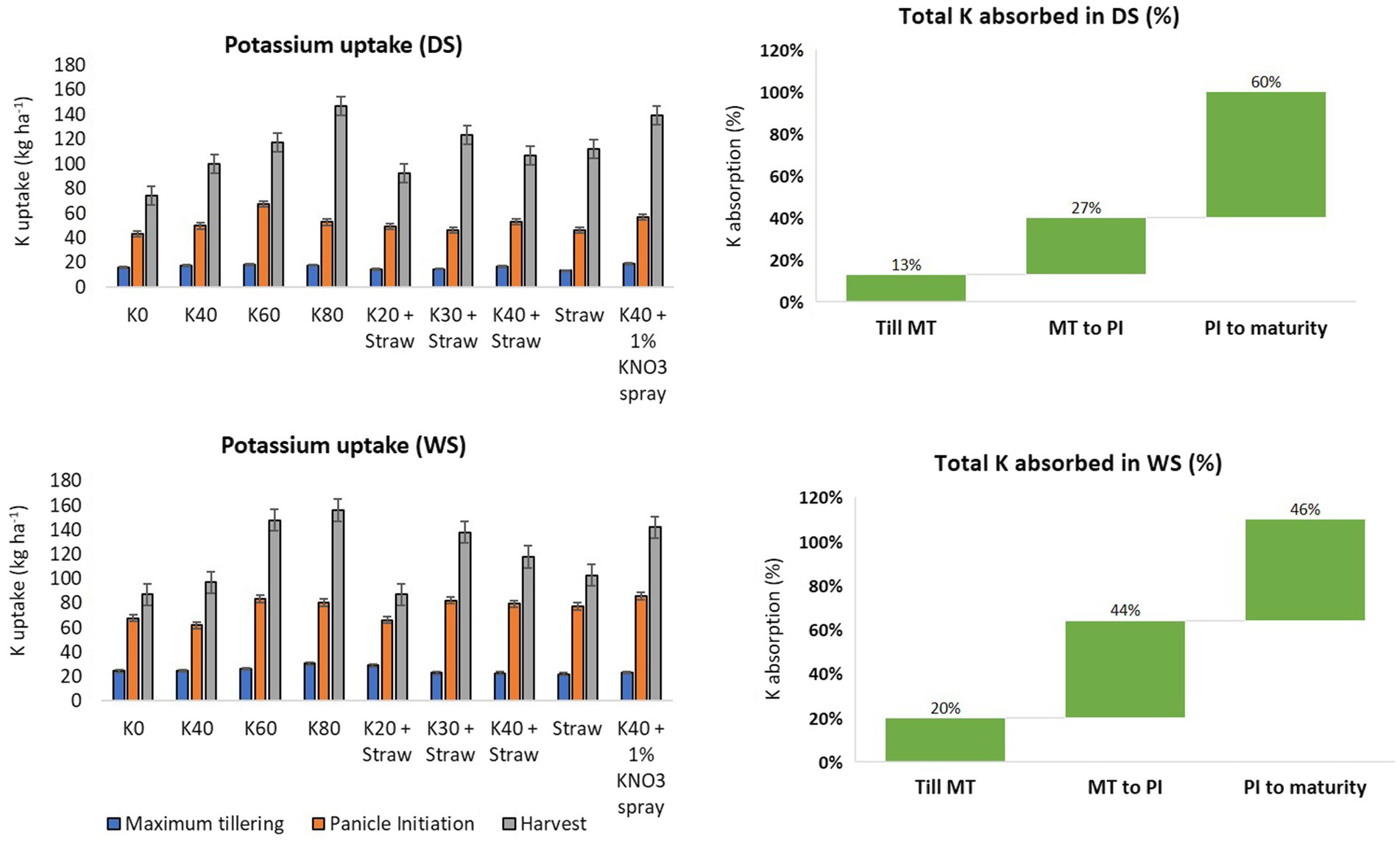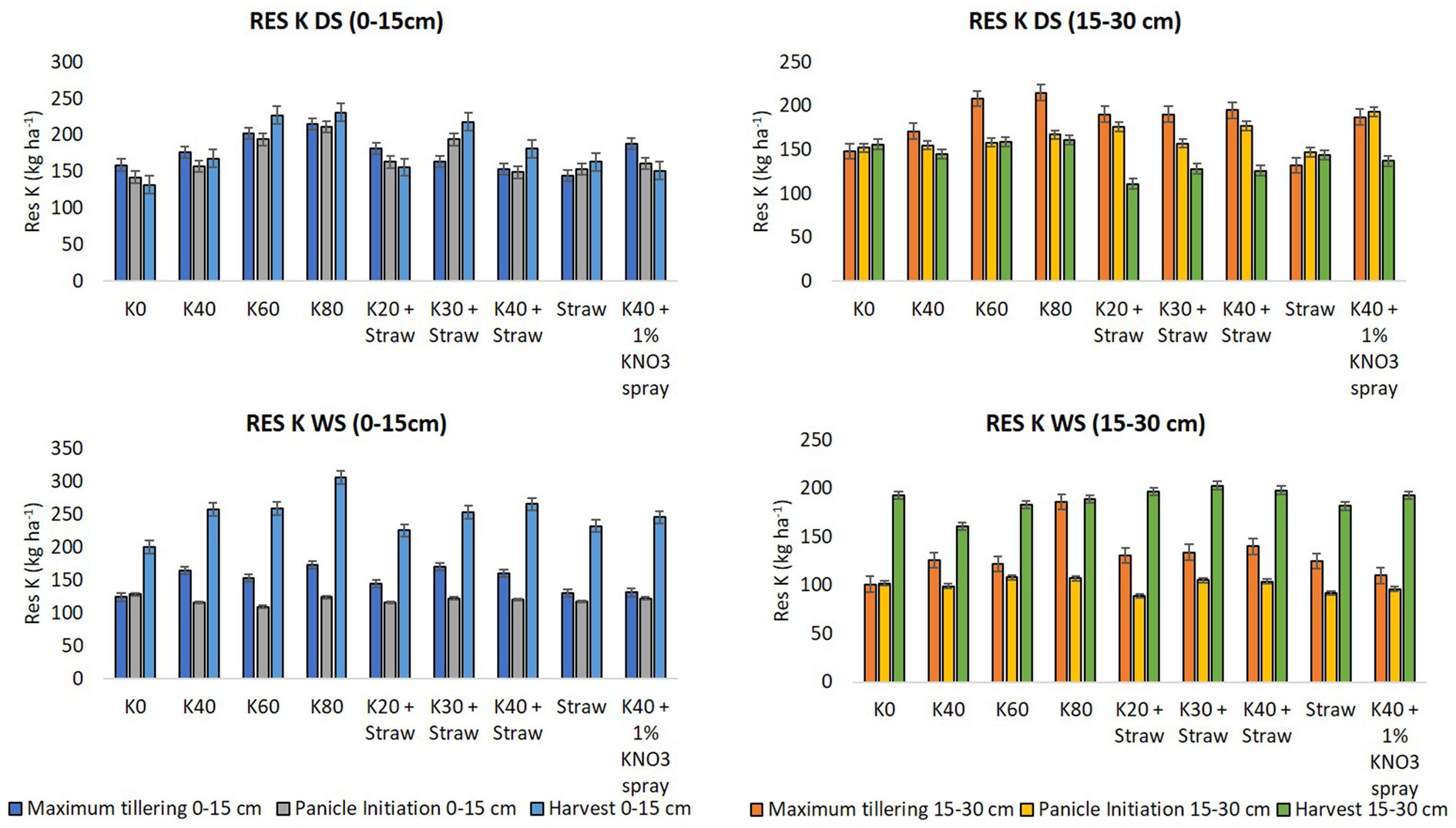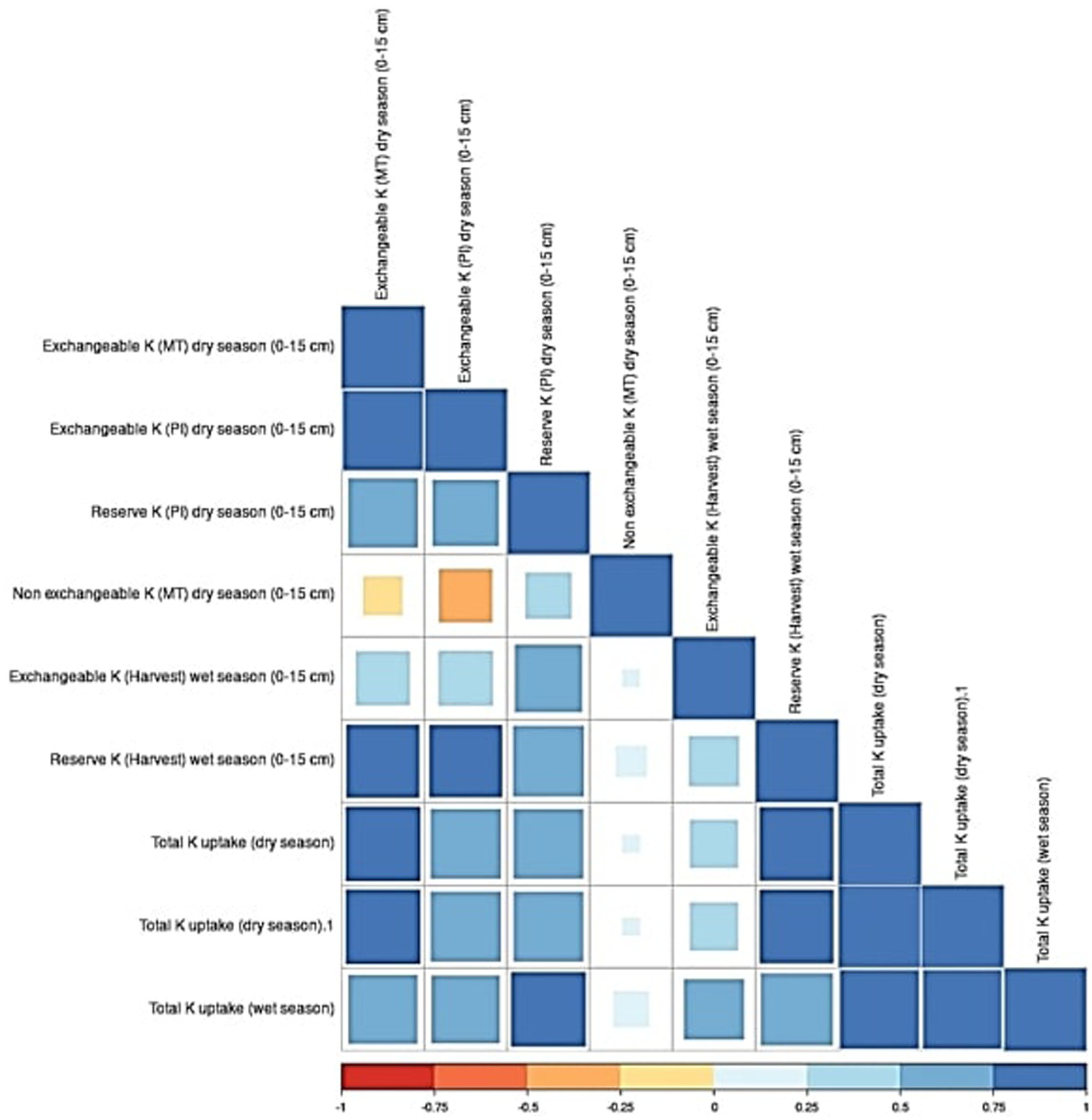- 1Department of Soil Science & Agricultural Chemistry, Faculty of Agricultural Sciences, Siksha ‘O’ Anusandhan (DU), Bhubaneswar, India
- 2Orissa University of Agriculture & Technology, Bhubaneswar, India
- 3School of Natural Resource Management, College of Post Graduate Studies of Agricultural Sciences, CAU, Imphal, India
- 4International Rice Research Institute, Los Banos, Philippines
- 5Queensland Alliance for Agriculture and Food Innovation(QAAFI), University of Queensland, St Lucia, QLD, Australia
- 6Department of Soil Science & Agricultural Chemistry, Bihar Agricultural University, Bhagalpur, India
- 7International Rice Research Institute, New Delhi, India
Rice, a staple crop in Asia, is critical for the region’s food security. However, intensive rice farming has led to substantial potassium (K) depletion in soils, undermining soil fertility and crop productivity. This study assessed the impact of different K management strategies on soil K dynamics, balance, and crop uptake in a puddled, transplanted rice–rice system in Odisha, India, during dry (December–April) and wet (June–October) seasons. The experiment involved nine treatments, including combinations of chemical fertilizers, straw application, and foliar spray, arranged in a randomized block design (RBD). Grain yield was significantly higher when applying chemical fertilizer and foliar spray (3.9 t ha−1 in the dry season and 5.4 t ha−1 in the wet season) compared to the control (2.7 and 4.2 t ha−1, respectively). Higher levels of exchangeable and reserve K were retained with chemical fertilizer applications, while reduced fertilizer doses combined with straw utilized more non-exchangeable K. The dry season exhibited a greater shift in non-exchangeable K, indicative of larger soil K depletion. Treatments combining reduced fertilizer doses with straw yielded a positive K balance, in contrast to the negative balance observed with chemical fertilizers alone. Correlation analyses indicated that reserve and non-exchangeable K significantly contributed to maintaining available K levels in the soil solution, thereby supporting continuous crop K uptake. These findings highlight the necessity of integrating reserve and non-exchangeable K dynamics into nutrient management strategies to ensure sustainable rice production.
1 Introduction
Rice is an essential crop for global food security, particularly in Asia, where it is a primary dietary staple. As one of the leading rice-producing nations, India has approximately 35% of its agricultural land for rice cultivation, contributing nearly 40% to the total food grain production. Despite this significant contribution, rice productivity in India remains suboptimal due to many agronomic and resource-related challenges (Sreekanth et al., 2017; Singh et al., 2021). This disparity necessitates a more sustainable approach to enhancing rice yield while ensuring soil health and long-term agricultural viability.
Potassium (K), an essential macronutrient, plays a pivotal role in the growth and productivity of rice. It is involved in critical physiological processes such as enzyme activation, osmoregulation, and photosynthesis, directly influencing yield and quality. However, intensive rice farming practices, driven by the need to meet the demands of a growing population, have led to substantial depletion of soil K reserves, undermining soil fertility. Studies have shown that Indian soils are predominantly deficient in potassium, with approximately 50% categorized as K-deficient (Srinivasarao et al., 2011; Sanyal et al., 2014). The reliance on imported potassic fertilizers, coupled with insufficient application rates, exacerbates this issue, leading to a negative soil K balance (Kumar et al., 2018). The introduction of high-yielding rice varieties during the Green Revolution further intensified nutrient depletion in soils. It is estimated that rice removes approximately 15 kg of nitrogen (N), 4 kg of phosphorus (P2O5), and 24 kg of K2O per ton of grain produced (Attanandana et al., 2010). Despite this, the recommended dose of potassic fertilizer for wetland rice in India is only 40–60 kg of K2O per hectare, which is significantly lower than the recommended nitrogen application rates (Saha et al., 2009; Mohapatra et al., 2017). Persistent under application of K fertilizers has led to a negative K balance, particularly in soils subjected to continuous rice cultivation. This imbalance not only reduces soil K availability but also affects the uptake efficiency of other essential nutrients, thereby limiting crop productivity.
An emerging challenge in rice production is the depletion of both exchangeable and non-exchangeable forms of soil potassium (Das et al., 2022). Research has indicated that while exchangeable K can be replenished through fertilizer applications, non-exchangeable and reserve K contribute significantly to the crop’s nutrient requirements (Rao and Srinivas, 2017). Over time, intensive cultivation practices have reduced the soil’s ability to release non-exchangeable K, necessitating alternative management strategies to maintain soil fertility (Lalitha and Dhakshinamoorthy, 2014; Alomar and Jena, 2023). Integrating organic and inorganic nutrient sources has been proposed as a sustainable approach to address these challenges. Crop residue incorporation, for instance, not only enhances soil organic matter but also contributes to the slow release of K, thereby improving soil K dynamics. Since 90% of the world’s rice is produced in Asia, managing rice straw after harvest is crucial to the rice production cycle. In Asia, rice is traditionally harvested by hand, with only a small amount of straw left in the field, after being cut and carried to a central threshing place for grain and straw separation. Since rice straw was regarded as a waste commodity, it was either burned or turned into animal bedding or fodder. However, with the increasing use of combine harvesters in the region, large amounts of rice straw are now left in the field. Studies have shown that in situ incorporation of rice straw into the soil enhances nutrient recycling, increases soil organic carbon (C), and improves the yields of subsequent crops (Gupta et al., 2007; Chivenge et al., 2020). Studies have demonstrated that when combined with reduced doses of chemical fertilizers, straw soil application can improve the K balance and maintain soil health (Witt et al., 1999; Hou et al., 2021). Similarly, foliar application of potassium nitrate has been found to enhance nutrient use efficiency and crop productivity under various stress conditions (Brar and Brar, 2004; Adhikari et al., 2019).
Given the critical role of potassium in rice cultivation and the pressing need for sustainable nutrient management practices, this study aims to evaluate the effects of different K management strategies on soil K dynamics, crop uptake, and grain yield in a puddled, transplanted rice–rice cropping system. The experiment, conducted in Odisha, India, during dry and wet seasons, included treatments combining chemical fertilizers, straw application, and foliar sprays. By analyzing the contributions of exchangeable, non-exchangeable, and reserve K to the overall nutrient supply, this study seeks to provide insights into optimizing potassium management for enhanced productivity and soil health.
This research addresses key questions relevant to sustainable rice farming: How do different potassium management practices influence soil K dynamics across seasons? What role do non-exchangeable and reserve K play in maintaining soil fertility? And how can integrated nutrient management approaches contribute to a positive K balance while sustaining high crop yields? The findings aim to inform nutrient management strategies that are not only effective but also economically viable and environmentally sustainable for smallholder rice farmers in India and similar agroecological contexts.
2 Materials and methods
2.1 Experimental site and climate
The field experiment was conducted at the Central Research Station of Orissa University of Agriculture and Technology (OUAT), Bhubaneswar, India (20°15′N, 81°52′E; 25.5 m above sea level), during the dry (December–April) and wet (June–October) seasons. The site is in the Eastern and South-Eastern Coastal Plain agroclimatic zone, characterized by a hot and humid climate. The mean annual rainfall is 1,467 mm, approximately 70% occurring between July and September. The mean maximum and minimum temperatures are 33.2°C and 21.4°C, respectively. The soil at the site is sandy loam with a pH of 5.87, medium organic carbon (0.39%), low nitrogen (alkaline KMnO4-N: 170 kg ha−1), high phosphorus (0.5-M NaHCO3-P: 21 kg ha−1), and low exchangeable potassium (1 N NH4OAc-K: 58 kg ha−1). Non-exchangeable and reserve potassium was measured at 123 and 181 kg ha−1, respectively, in the 0–15-cm soil depth. At 15–30- and 30–45-cm depths, exchangeable potassium was 59 and 53 kg ha−1, respectively, with corresponding increases in non-exchangeable and reserve potassium. As a result of the shallow water table (1 m), the land remains poorly drained during the rainy season but moderately well drained during the summer.
2.2 Treatments
The experiment was designed as a randomized block design (RBD) with three replications to evaluate nine treatments: T1 served as the control with no potassium application; T2 involved the application of 40 kg K₂O ha−1; T3 involved 60 kg K₂O ha−1; T4 included 80 kg K₂O ha−1; T5 combined 20 kg K₂O ha−1 with straw (3 t ha−1); T6 used 30 kg K₂O ha−1 with straw; T7 combined 40 kg K₂O ha−1 with straw; T8 incorporated straw alone; and T9 involved 40 kg K₂O ha−1 combined with a 1% KNO₃ foliar spray at the panicle initiation stage. The treatments were categorized broadly into control (T1), fertilizer K (T2, T3, and T4), fertilizer K with straw (T5, T6, and T7), straw only (T8), and fertilizer K with foliar spray (T9).
2.3 Crop management
The medium-duration (120–125 days) rice variety “Lalat” was used in the rice–rice cropping system. The experimental plots measured 6 m × 5 m, with seedlings (25 days old) transplanted at a 20 cm × 10 cm spacing. Each plot received 30 kg N ha−1 (urea), 40 kg P ha−1 (diammonium phosphate), and 25 kg Zn ha−1 (ZnSO₄) at transplanting. An additional 50 kg N ha−1 was applied in two splits (2:1 ratio) at 20 and 50 days after transplanting (DAT). Potassium was applied as muriate of potash (MOP) in two equal splits at basal application and 50 DAT. Weed management included pretilachlor application (500 mL ha−1) at the initial stage, followed by manual weeding as needed. The pest and disease management included applications of SAAF (2 g L−1), streptocycline (0.15 g L−1), and Furadan (10 kg acre−1).
2.4 Straw addition and management
For treatments involving straw incorporation, panicles were removed, leaving 5 cm of straw, and the field was allowed to dry before incorporation. The straw was mixed into the soil using a power tiller to a shallow depth, followed by a second plowing after 15 days to enhance decomposition. Approximately 3 t ha−1 of straw, contributing ~45 kg K ha−1, was incorporated into designated plots.
2.5 Soil sampling and analysis
Soil samples were collected from three depths—0–15, 15–30, and 30–45 cm—at the beginning of the experiment, mid-season at 30 and 60 DAT, and after harvest. The collected samples were air-dried, crushed, and sieved through a 2-mm mesh before analysis. Exchangeable potassium was determined using the ammonium acetate method (Hanway and Heidel, 1952), while reserve potassium was extracted with nitric acid following the method developed by Wood and De Turk (1941). Non-exchangeable potassium was measured using the procedure described by Black (1965). Soil pH (Jackson, 1968), nitrogen content using the alkaline KMnO4 (Subbiah and Asija, 1956), and phosphorus using the sodium bicarbonate extraction method (Page, 1982) were also analyzed.
2.6 Plant sampling and analysis
Plant samples were collected at maximum tillering, panicle initiation, and harvest stages. Samples were dried (70 ± 5°C), weighed, and ground using a Willey mill. Potassium content was analyzed at all growth stages. Grain and straw samples at harvest were digested using HNO3–HClO4 (3:2), diluted with distilled water, and analyzed using a flame photometer. Phosphorus content was determined using the Vanadomolybdate yellow color method, and nitrogen was analyzed using the micro-Kjeldahl method.
2.7 Statistical analysis
Data were analyzed using analysis of variance (ANOVA) (Gomez and Gomez, 1984; Panse and Sukhatme, 1961). The least significant difference (LSD) at a 0.05 probability level was used to compare treatment means. Correlation analysis was conducted to evaluate relationships between variables, and figures were prepared using GRAPES 1.1.0 (Kerela Agriculture University) (Gopinath et al., 2020).
3 Results
3.1 Grain yield
The K management practices significantly influenced grain yield in both dry (DS) and wet (WS) seasons. In the DS, grain yield ranged from 2.69 t ha−1 in the control (T1) to 3.84 t ha−1 in T9, which combined 40 kg K₂O ha−1 with a 1% KNO₃ foliar spray (Table 1). Treatments T3, T4, and T6 yielded at par with T9, while other treatments produced significantly lower yields, and in the WS, grain yield varied between 4.21 t ha−1 in T1 and 5.35 t ha−1 in T9. The treatment T9 was at par with T4, T6, and T7 and differed significantly from all other treatments.
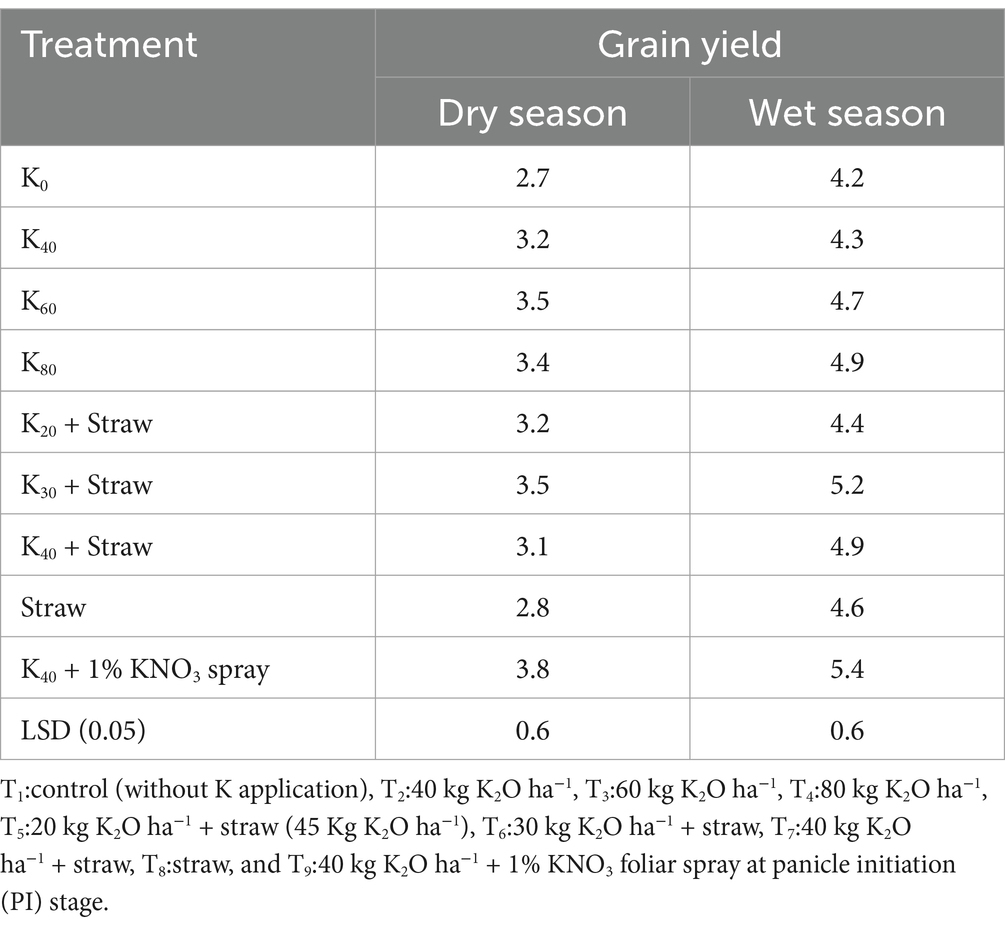
Table 1. Effect of different potassium management practices on rice grain yield during the cropping seasons (dry and wet) in the rice–rice cropping system.
3.2 Plant K uptake
Potassium uptake by the crop was lower in the DS than that of the WS at all growth stages. Maximum K uptake in the DS occurred between panicle initiation (PI) and harvest, whereas in the WS, the uptake was demonstrated to be higher between maximum tillering (MT) and PI (Figure 1). In the DS, K uptake at MT ranged from 16.1 kg ha−1 (T8) to 19.1 kg ha−1 (T9), while in the WS, uptake at the same stage ranged from 21.9 kg ha−1 (T8) to 30.7 kg ha−1 (T4). At harvest, total K uptake in the DS varied between 74 kg ha−1 (T1) and 147 kg ha−1 (T4), while in the WS, it ranged from 87 kg ha−1 (T1 and T5) to 156 kg ha−1 (T4).
3.3 Exchangeable K
Exchangeable K levels were generally higher in the DS compared to the WS. In the DS, exchangeable K in the surface layer (0–15 cm) ranged from 68.5 kg ha−1 (T1) to 117.8 kg ha−1 (T4) at MT, whereas in the WS, it ranged from 42.4 kg ha−1 (T1) to 81.7 kg ha−1 (T6) at the same stage (Figure 2). In the subsurface layer (15–30 cm), exchangeable K in the DS varied from 42.1 kg ha−1 (T1) to 78.4 kg ha−1 (T4), while in the WS, it ranged from 33.1 kg ha−1 (T1) to 55.3 kg ha−1 (T7). At PI in the DS, surface exchangeable K varied from 56.2 kg ha−1 (T1) to 94.7 kg ha−1 (T4), with subsurface values ranging between 49.9 kg ha−1 (T1) and 72.2 kg ha−1 (T4). At harvest, exchangeable K in the DS ranged between 47.9 kg ha−1 (T1) and 79.6 kg ha−1 (T4) in the surface and 48.8 kg ha−1 (T1) to 62.5 kg ha−1 (T4) in the subsurface. In the WS, exchangeable K at harvest ranged from 35.6 kg ha−1 (T1) to 63.3 kg ha−1 (T3) in the surface and 47.1 kg ha−1 (T5) to 70.9 kg ha−1 (T3) in the subsurface.
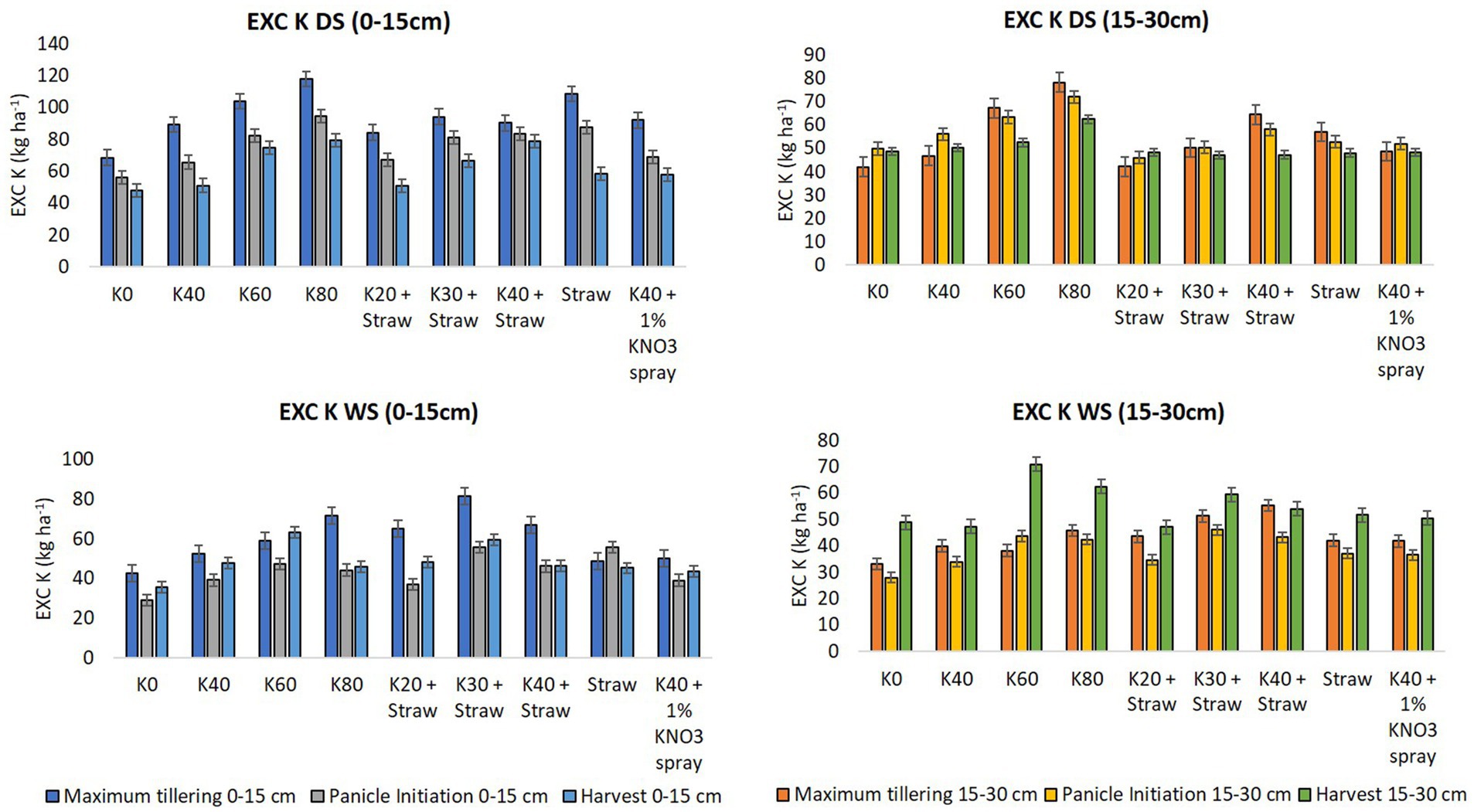
Figure 2. Exchangeable potassium (kg ha−1) at different growth stages of rice crop during DS and WS.
3.4 Non-exchangeable K
Non-exchangeable K (NE-K) varied significantly among treatments, particularly in the DS (Figure 3). At MT in the DS, surface NE-K (0–15 cm) ranged from 35.5 kg ha−1 (T8) to 97.9 kg ha−1 (T5), while in the subsurface layer (15–30 cm), NE-K ranged from 74.5 kg ha−1 (T8) to 147.7 kg ha−1 (T5). In the WS, surface NE-K ranged from 78.8 kg ha−1 (T5) to 111.2 kg ha−1 (T2), while subsurface values varied between 68.0 kg ha−1 (T1) and 140.5 kg ha−1 (T4) (Figure 3). At harvest in the DS, surface NE-K ranged from 83.3 kg ha−1 (T9) to 152.4 kg ha−1 (T3), while subsurface NE-K varied between 63.6 kg ha−1 (T5) and 106.2 kg ha−1 (T3). In the WS, surface NE-K at harvest ranged from 164.7 kg ha−1 (T1) to 226.2 kg ha−1 (T4), with subsurface values ranging from 130.6 kg ha−1 (T8) to 149.5 kg ha−1 (T5).
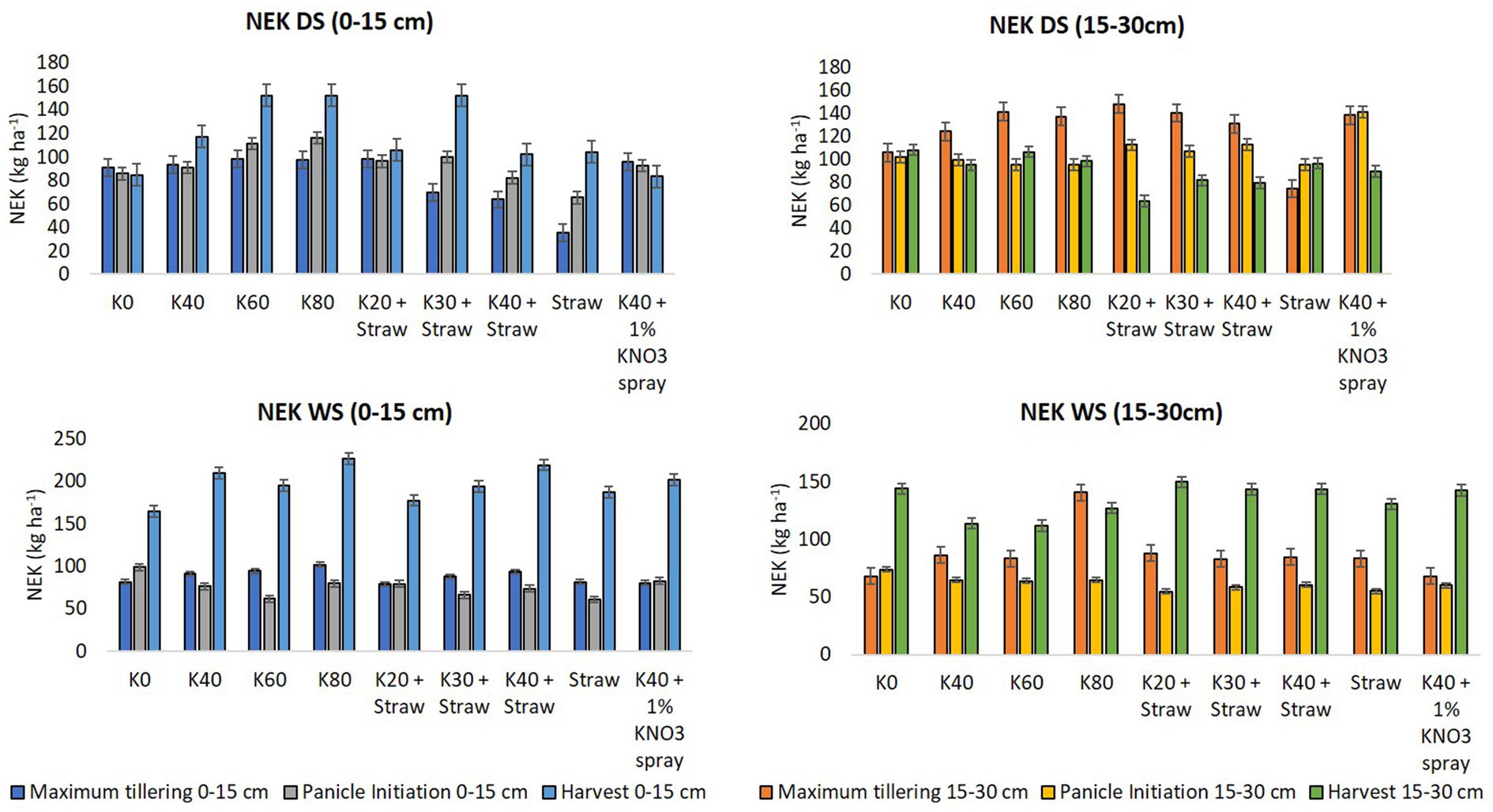
Figure 3. Non-exchangeable potassium (kg ha−1) at different growth stages of rice crop during DS and WS.
3.5 Reserve K
Reserve K levels were consistently higher in the DS compared to the WS. At MT, reserve K in the DS ranged from 144 kg ha−1 (T1) to 215 kg ha−1 (T4) in the surface soil (0–15 cm), while in the subsurface soil (15–30 cm), it ranged from 148 kg ha−1 (T1) to 215 kg ha−1 (T4). In the WS, surface reserve K varied from 124 kg ha−1 (T1) to 173 kg ha−1 (T4), while in the subsurface layer, it ranged from 101 kg ha−1 (T1) to 186 kg ha−1 (T4) (Figure 4). At harvest in the DS, reserve K in the surface soil ranged between 132 kg ha−1 (T1) and 232 kg ha−1 (T4), while subsurface values ranged from 156 kg ha−1 (T1) to 161 kg ha−1 (T4). In the WS, surface reserve K at harvest ranged from 200 kg ha−1 (T1) to 306 kg ha−1 (T4), while subsurface values varied from 193 kg ha−1 (T1) to 203 kg ha−1 (T6).
3.6 Correlation of soil K forms with K uptake
Correlation analysis showed significant relationships between different forms of soil K and plant K uptake (Figure 5). Total K uptake was significantly correlated with available K at MT (R2 = 0.63), PI (R2 = 0.49), and harvest (R2 = 0.50) stages. Reserve K at PI and harvest stages also significantly correlated with total K uptake (R2 = 0.52). Non-exchangeable K significantly correlated with K uptake at MT (R2 = 0.43).
3.7 K balance and partitioning of K uptake
Potassium balance varied significantly among treatments and seasons (Table 2). In the DS, K balance ranged from −103 kg ha−1 (T1) to 53 kg ha−1 (T5). In the WS, the K balance varied between −87 kg ha−1 (T1) and 65 kg ha−1 (T6). Annually, the total K balance ranged from −140 kg ha−1 (T9) to 89 kg ha−1 (T7). Treatments receiving straw, either alone or in combination with reduced K fertilizer doses, exhibited positive K balances, whereas treatments with higher K fertilizer doses alone showed negative balances.
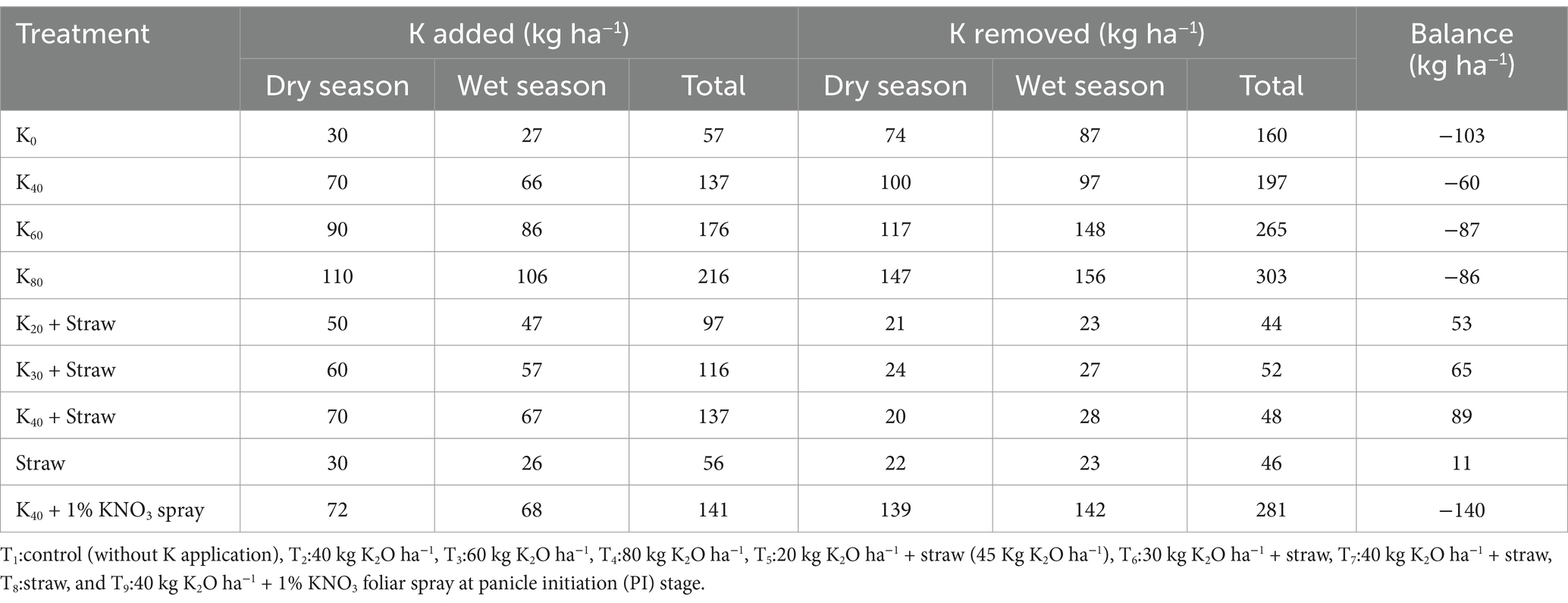
Table 2. Effect of potassium (K) management practices on K balance during dry and wet seasons in the rice–rice cropping system.
The partitioning of K uptake differed between seasons (Figure 1). In the WS, 16–18% of total K uptake occurred by MT, 38–44% between MT and PI, and 40–44% between PI and maturity. In contrast, in the DS, 12–13% of total K uptake occurred by MT, 23–27% between MT and PI, and 59–64% between PI and maturity. These results highlight the greater reliance on post-PI K uptake in the DS compared to the WS.
4 Discussion
4.1 Grain yield and K uptake
Grain yield and K uptake were significantly influenced by applying K through fertilizers, straw incorporation for two seasons, and foliar sprays. The study observed higher grain yields in the wet season (WS) than in the dry season (DS), which can be attributed to differences in climatic conditions and water availability, enhancing nutrient uptake efficiency during the WS. Fertilizer treatments with higher K doses or fertilizers combined with straw generally resulted in higher yields than control or straw-only treatments. This aligns with the findings from Kumar et al. (2018), who emphasized the positive impact of integrated nutrient management on rice productivity.
Interestingly, the partitioning of K uptake varied between seasons. In the DS, a larger proportion of K uptake occurred post-panicle initiation (PI), with 59–64% of the total K absorbed during this stage, underscoring the importance of late-season K availability. Conversely, in the WS, K uptake was more evenly distributed across the growth stages, with 38–44% absorbed between maximum tillering and PI and 40–44% between PI and maturity. These patterns corroborate earlier studies by Kumbhar and Sonar (1979) and Kalita (2020), highlighting the need for season-specific K management to optimize crop uptake and yield.
4.2 Changes in soil potassium
The study showed that available K (measured as exchangeable K) was consistently higher in the topsoil than in the subsoil across both seasons. However, the DS recorded higher available K levels than the WS. This can be attributed to greater K release from soil reserves during the DS, possibly due to soil drying and reduced leaching. As observed in other studies, the decline in available K from the MT to PI stage in the surface soil reflects active crop uptake (Lalitha and Dhakshinamoorthy, 2014). The treatments receiving fertilizers maintained higher available K levels than control or straw-only treatments, demonstrating the efficacy of chemical fertilizers in replenishing soil K. The integration of straw with fertilizers also maintained relatively high available K levels, suggesting that straw contributes to the slow release of K over time, consistent with findings by Saha et al. (2009). Incorporation of rice straw has also been observed to improve soil pH, soil organic C, and overall nutrient content as compared to the initial conditions (Thanh et al., 2016).
Non-exchangeable K played a significant role in maintaining K availability during crop growth. The conversion of NE-K to exchangeable forms was evident in the DS, where NE-K levels declined at harvest. This indicates active soil K release to meet crop demands, particularly under intensive cropping conditions due to dynamic equilibrium (Wihardjaka et al., 2022). The higher NE-K levels recorded in the WS at harvest can be attributed to reduced crop uptake and enhanced K retention due to higher soil moisture levels (Venkateshwarlu et al., 2014). The study’s findings underscore the need to consider NE-K dynamics in nutrient management strategies, as this form serves as a critical reservoir for replenishing soil K during periods of high crop demand.
Reserve K, the most stable form of soil K, showed seasonal fluctuations. In both DS and WS, reserve K declined from MT to PI, followed by an increase at harvest. This pattern suggests the mobilization of reserve K to meet crop needs during critical growth stages, followed by replenishment through root turnover and microbial activity. The higher reserve K levels in the WS than those of the DS may reflect enhanced mineral weathering and nutrient cycling under wet conditions. The study also highlighted that fertilizer-only treatments maintained higher reserve K levels than treatments involving straw, indicating the effectiveness of chemical fertilizers in stabilizing this K pool. However, the combined use of fertilizers and straw demonstrated a balanced approach, maintaining adequate reserve K while improving soil organic matter, a critical factor for long-term soil health (Witt et al., 1999; Wang et al., 2023).
4.3 K balance
The K balance analysis indicated contrasting trends among treatments. Treatments involving straw incorporation, either alone or in combination with reduced K fertilizer doses, exhibited positive K balances, indicating sustainable nutrient management. In contrast, treatments relying solely on chemical fertilizers recorded negative K balances (Mohapatra et al., 2023), highlighting the risk of soil K depletion under intensive farming. These findings are consistent with earlier studies by Wihardjaka et al. (1999) and Balik et al. (2019), emphasizing the importance of integrating organic amendments to offset nutrient mining.
The annual K balance ranged from −140 kg ha−1 in the treatment with 40 kg K₂O ha−1 and foliar spray to +89 kg ha−1 in the treatment combining 40 kg K₂O ha−1 with straw. This stark contrast underscores the critical role of straw in mitigating K losses and enhancing nutrient recycling. The positive K balance observed with straw-based treatments also aligns with the findings of Chivenge et al. (2020), who reported improved nutrient cycling and soil fertility with residue incorporation in rice systems. The rice straw also provides a substrate to promote biodiversity through the flourishing of invertebrates that decompose the straw, which in turn enhances nutrient cycling in paddy soils (Schmidt et al., 2015).
4.4 Implications for sustainable nutrient management
The results of this study have significant implications for developing sustainable nutrient management strategies in rice-based cropping systems. First, the findings highlight the need to integrate inorganic and organic nutrient sources to optimize soil K dynamics and crop productivity. While chemical fertilizers are effective in maintaining high levels of exchangeable and reserve K, the inclusion of straw or other organic amendments enhances soil organic matter, improves nutrient cycling, and ensures long-term soil fertility. This integrated approach is particularly relevant for smallholder farmers, who face resource constraints and rely heavily on soil fertility for sustained crop production (Adhikari et al., 2019).
Second, the study underscores the importance of considering NE-K and reserve K in nutrient recommendations. Current fertilizer recommendations often focus on exchangeable K, overlooking the contributions of these less available forms. Incorporating NE-K and reserve K into nutrient management strategies can help maintain soil K reserves and ensure a continuous supply of K to crops, particularly under intensive farming conditions.
Third, the seasonal variations in K dynamics observed in this study highlight the need for season-specific nutrient management. In the DS, strategies should focus on enhancing late-season K availability to support the high demand during the reproductive phase. In the WS, a more balanced approach that ensures steady K availability throughout the growing season may be more effective. Tailoring nutrient management practices to seasonal requirements can improve nutrient use efficiency, reduce losses, and contribute to sustainable intensification.
Finally, the positive K balance achieved with straw-based treatments highlights the potential of residue recycling as a cost-effective and environmentally friendly alternative to chemical fertilizers. Farmers can reduce their dependence on external inputs by returning crop residues to the soil, lowering production costs, and mitigating environmental impacts associated with fertilizer use. However, the study also points to the need for appropriate management practices, such as ensuring adequate decomposition of straw before planting, to maximize its benefits.
4.5 Future research directions
While this study provides valuable insights, several areas warrant further investigation. Long-term studies are needed to assess the cumulative effects of different K management strategies on soil health, crop productivity, and environmental sustainability. In addition, research should explore the potential of other organic amendments, such as green manures and composts, to enhance K dynamics and support sustainable rice production. The interactions between K and other nutrients, such as nitrogen and phosphorus, also merit further study to optimize nutrient management in rice-based systems. Finally, there is a need for socioeconomic studies to evaluate the feasibility and adoption of integrated nutrient management practices among smallholder farmers.
5 Conclusion
This study highlights the pivotal role of potassium (K) management strategies in maintaining soil K dynamics and sustaining rice productivity in a rice–rice cropping system. Integrating inorganic fertilizers with organic amendments, such as rice straw, emerges as a viable approach to achieving a positive K balance while enhancing soil fertility. Chemical fertilizers effectively maintain higher levels of exchangeable and reserve K, supporting immediate crop uptake. Conversely, treatments incorporating straw with reduced K fertilizer doses contribute to the mobilization of non-exchangeable K, ensuring a steady nutrient supply during critical growth stages. Seasonal variations in K dynamics were evident, with the dry season showing greater depletion of soil K reserves, necessitating targeted nutrient management to address this challenge. Treatments combining straw and reduced K fertilizer doses demonstrated a sustainable balance, minimizing nutrient losses and mitigating soil degradation. These findings underscore the importance of including non-exchangeable and reserve K in nutrient management recommendations to ensure long-term soil health and productivity. Adopting integrated nutrient management strategies tailored to specific seasonal requirements can optimize nutrient use efficiency, reduce external input dependency, and promote sustainable rice cultivation, particularly for resource-constrained smallholder farmers. Future studies should focus on the long-term implications of such strategies on soil and crop health.
Data availability statement
The raw data supporting the conclusions of this article will be made available by the authors, without undue reservation.
Author contributions
SM: Formal analysis, Writing – original draft, Writing – review & editing, Investigation, Visualization. KR: Conceptualization, Data curation, Validation, Writing – original draft, Supervision. CK: Project administration, Resources, Writing – review & editing. AM: Supervision, Validation, Writing – review & editing. SY: Project administration, Resources, Supervision, Writing – review & editing. RP: Data curation, Writing – review & editing. AKM: Resources, Writing – review & editing. SS: Conceptualization, Funding acquisition, Supervision, Writing – review & editing.
Funding
The author(s) declare that no financial support was received for the research and/or publication of this article.
Acknowledgments
We acknowledge financial support from the United States Agency for International Development (USAID) and the Bill & Melinda Gates Foundation (BMGF)-funded Cereal Systems Initiative for South Asia (CSISA) project through the International Rice Research Institute (IRRI) and the Odisha University of Agriculture and Technology (OUAT).
Conflict of interest
The authors declare that the research was conducted in the absence of any commercial or financial relationships that could be construed as a potential conflict of interest.
The author(s) declared that they were an editorial board member of Frontiers, at the time of submission. This had no impact on the peer review process and the final decision.
Publisher’s note
All claims expressed in this article are solely those of the authors and do not necessarily represent those of their affiliated organizations, or those of the publisher, the editors and the reviewers. Any product that may be evaluated in this article, or claim that may be made by its manufacturer, is not guaranteed or endorsed by the publisher.
References
Adhikari, B., Dhungana, S. K., and Kim, I. D. (2019). Effect of foliar application of potassium fertilizers on soybean plants under salinity stress. J. Saudi Soc. Agric. Sci. 19, 261–269. doi: 10.1016/j.jssas.2019.02.001
Alomar, R., and Jena, D. (2023). Potassium and brackish water irrigation influence electrical conductivity, potassium dynamic, and maize yield in coastal saline soil. Commun. Soil Sci. Plant Anal. 55, 723–734. doi: 10.1080/00103624.2023.2276270
Attanandana, T., Kongton, S., Boonsompopphan, B., Polwatana, A., Verapatananirund, P., and Yost, R. (2010). Site-specific nutrient management of irrigated rice in the central plain of Thailand. J. Sustain. Agric. 34, 258–269. doi: 10.1080/10440041003613297
Balik, J., Cerny, J., Kulhanek, M., Sedlar, O., and Suran, P. (2019). Balance of potassium in two long-term field experiments with different fertilization treatments. Plant Soil Environ. 65, 225–232. doi: 10.17221/109/2019-PSE
Brar, M. S., and Brar, A. S. (2004). Foliar nutrition as a supplement to soil fertilizer application to increase yield of upland cotton (Gossypium hirsutum). Indian J. Agric. Sci. 74, 472–475.
Chivenge, P., Rubianes, F., Van Chin, D., Van Thach, T., Khang, V. T., Romasanta, R., et al. (2020). Rice straw incorporation influences nutrient cycling and soil organic matter. Sustainable rice straw management, 131–144.
Das, D., Sahoo, J., Raza, M. B., et al. (2022). Ongoing soil potassium depletion under intensive cropping in India and probable mitigation strategies. A review. Agron. Sustain. Dev. 42:4. doi: 10.1007/s13593-021-00728-6
Gomez, K. A., and Gomez, A. A. (1984). Statistical procedures for agricultural research. New York: John Wiley and Sons Inc.
Gopinath, P. P., Parsad, R, Joseph, B, and Adarsh, V. S. (2020). GRAPES: General Rshiny Based Analysis Platform Empowered by Statistics. doi: 10.5281/zenodo.4923220
Gupta, R., Ladha, J., Singh, J., Singh, G., and Pathak, H. (2007). Yield and phosphorus transformations in a rice–wheat system with crop residue and phosphorus management. Soil Sci. Soc. Am. J. 71, 1500–1507. doi: 10.2136/sssaj2006.0325
Hanway, J., and Heidel, H. (1952). Soil analysis methods as used in Iowa state college soil testing laboratory. Iowa State Coll. Agric. Bull. 57, 1–3.
Hou, Y., Xu, X., Kong, L., Zhang, L., and Wang, L. (2021). The combination of straw return and appropriate K fertilizer amounts enhances both soil health and rice yield in Northeast China. Agron. J. 113, 5424–5435. doi: 10.1002/agj2.20805
Kalita, R. (2020). Department of Agronomy (Doctoral dissertation, Assam Agricultural University Jorhat).
Kumar, S. I., Gulati, J., Yadav, S. R., Yadav, R. S., Moharana, P. C., Meena, R. L., et al. (2018). Impact of low potassium fertilization on potassium transformation under different crop management systems in western plain of arid India. J. Plant Nutr. 41, 411–424. doi: 10.1080/01904167.2017.1381121
Kumbhar, D. D., and Sonar, K. R. (1979). Performance of rice varieties grown under upland conditions. Jour Ind Soil Sc. 28, 178–183.
Lalitha, M., and Dhakshinamoorthy, M. (2014). Forms of soil potassium-a review. Agri. Rev. 35, 64–68. doi: 10.5958/j.0976-0741.35.1.008
Mohapatra, S., Rout, K. K., Khanda, C., Mishra, A., Yadav, S., Padbhushan, R., et al. (2023). Evaluation of different potassium management options under prevailing dry and wet seasons in puddled, transplanted rice. Sustainability 15:5819. doi: 10.3390/su15075819
Mohapatra, S., Rout, K. K., Khanda, C. M., Mukherjee, S. K., Mishra, A., Mahapatra, S. S., et al. (2017). Role of potassium on insect pests and diseases of puddled transplanted rice cv. Lalat in Odisha. ORYZA-An Int. J. Rice 54:314. doi: 10.5958/2249-5266.2017.00043.1
Page, A. I. (1982). Methods of soil analysis, part 2. Chemical and microbial properties. Madison WI, USA: Amer Soc Agron, 621–622.
Panse, V. G., and Sukhatme, P. V. (1961). Statistical methods for agricultural workers. 2nd Edn. New Delhi, India: Indian Council of Agricultural Research.
Rao, C. S., and Srinivas, K. (2017). Potassium dynamics and role of non-exchangeable potassium in crop nutrition. Indian J. Fertil. 13, 80–94.
Saha, P. K., Miah, M. A. M., Hossain, A. T. M. S., Rahman, F., and Saleque, M. A. (2009). Contribution of rice straw to potassium supply in rice-fallow-rice cropping pattern. Bangladesh J. Agril. Res. 34, 633–643. doi: 10.3329/bjar.v34i4.5839
Sanyal, S. K., Majumdar, K., and Singh, V. K. (2014). Nutrient management in Indian agriculture with special reference to nutrient mining—A relook. J. Indian Soc. Soil Sci. 62, 307–325.
Schmidt, A., Auge, H., Brandl, R., Heong, K. L., Hotes, S., Settele, J., et al. (2015). Small-scale variability in the contribution of invertebrates to litter decomposition in tropical rice fields. Basic Appl Ecol. 16, 674–680. doi: 10.1016/j.baae.2015.01.006
Singh, K. M., Ahmad, N., Pandey, V. V., Kumari, T., and Singh, R. (2021). Growth performance and profitability of Rice production in India: An assertive analysis. Econ. Aff. 66, 481–486. doi: 10.46852/0424-2513.3.2021.18
Sreekanth, M., Hakeem, A. H., Peer, Q. J. A., and Rashid, I. (2017). Low productivity of Indian agriculture with special reference on cereals. J. Pharmacogn. Phytochem. 6, 239–243.
Srinivasarao, C., Satyanarayana, T., and Venkateswarlu, D. B. (2011). Potassium mining in Indian agriculture: input and output balance. Karnataka J Agric Sci. 24, 20–28.
Subbiah, B. V., and Asija, G. L. (1956). A rapid procedure for the determination of available nitrogen in soils. Curr. Sci. 25, 259–260.
Thanh, N. D., Hoa, H. T. T., Hung, H. C., Nhi, P. T. P., and Thuc, D. D. (2016). Effect of fertilizer on rice yield improvement in coastal sandy soil of Thua Thien hue province. Hue Univ. J. Sci. Agric. Rural Dev. 119.
Venkateshwarlu, M., Ghosh, S. K., Patra, P. K., Pal, B., and Reddy, G. K. (2014). To study the effect of fertilizer and organic manure on dynamic changes of K under cropping sequence. Int. J. Appl. Biol. Pharm. Technol. 9, 2573–2582. doi: 10.20546/ijcmas.2020.905.294
Wang, Y., Liang, A., Bao, H., Chen, Q., Cao, Y., He, Y., et al. (2023). Potential of crop straw incorporation for replacing chemical fertilizer and reducing nutrient loss in Sichuan province. China. Environ. Pollution. 320:121034. doi: 10.1016/j.envpol.2023.121034
Wihardjaka, A., Harsanti, E. S., and Ardiwinata, A. N. (2022). Effect of fertilizer management on potassium dynamics and yield of rainfed lowland rice in Indonesia. Chilean J. Agric. Res. 82, 33–34.
Wihardjaka, A., Kirk, G. J. D., Abdulrachman, S., and Mamaril, C. P. (1999). Potassium balances in rainfed lowland rice on a light-textured soil. Field Crop Res. 64, 237–247. doi: 10.1016/S0378-4290(99)00045-3
Witt, C., Dobermann, A., Abdulrachman, S., Gines, H. C., Wang, G., Nagarajan, R., et al. (1999). Internal nutrient efficiencies of irrigated lowland rice in tropical and subtropical Asia. Field Crop Res. 63, 113–138. doi: 10.1016/S0378-4290(99)00031-3
Keywords: potassium management, rice yield, nutrient dynamics, foliar spray, residue incorporation, sustainable agriculture
Citation: Mohapatra S, Rout KK, Khanda C, Mishra A, Yadav S, Padbhushan R, Mishra AK and Sharma S (2025) Impact of potassium management on soil dynamics and crop uptake in rice systems. Front. Sustain. Food Syst. 9:1453311. doi: 10.3389/fsufs.2025.1453311
Edited by:
Amit Anil Shahane, Central Agricultural University, IndiaReviewed by:
Patrice Autfray, Institut National de la Recherche Agronomique (INRA), FranceYaping Ma, Ningxia University, China
Copyright © 2025 Mohapatra, Rout, Khanda, Mishra, Yadav, Padbhushan, Mishra and Sharma. This is an open-access article distributed under the terms of the Creative Commons Attribution License (CC BY). The use, distribution or reproduction in other forums is permitted, provided the original author(s) and the copyright owner(s) are credited and that the original publication in this journal is cited, in accordance with accepted academic practice. No use, distribution or reproduction is permitted which does not comply with these terms.
*Correspondence: Suchismita Mohapatra, c3VjaGk0NTY3QGdtYWlsLmNvbQ==; Kumbha Karna Rout, a2tyb3V0NDJAeWFob28uY29t; Ajay Kumar Mishra, YS5rLm1pc2hyYUBjZ2lhci5vcmc=; Sheetal Sharma, c2hlZXRhbC5zaGFybWFAaXJyaS5vcmc=
 Suchismita Mohapatra
Suchismita Mohapatra Kumbha Karna Rout2*
Kumbha Karna Rout2* Amit Mishra
Amit Mishra Sudhir Yadav
Sudhir Yadav Rajeev Padbhushan
Rajeev Padbhushan Ajay Kumar Mishra
Ajay Kumar Mishra Sheetal Sharma
Sheetal Sharma